Research and development of online - Realtime supervising system for low voltage grids
The recent trend of Smart Grid in the world has been applied to the
management, supervision of transformers and low voltage grid [1-4]. Monitoring
systems for distribution transformer and energy monitoring systems (BEMS) have
been used in some countries such as USA, Korea, India. However, these systems
are still expensive [5-9].
Vietnam currently has no specific regulation or model on low-voltage grid
monitoring and management system. In urban areas of Vietnam, distribution
substations often were installed near residential areas, markets and crowded places,
which pose a potential risk of unsafe operation.
Checking and measuring operating parameters of substations have mainly been
done by manual methods. Thus, it leads to labor-intensive, unsafe, incomplete -
inaccuracy data. Additionally, alarming & warning devices such as oil temperature
of transformer, oil level, steam relays, underground cable breakdown alarms are
on-site reading devices. Moreover, these devices are not able to store and transfer
data by themselves.
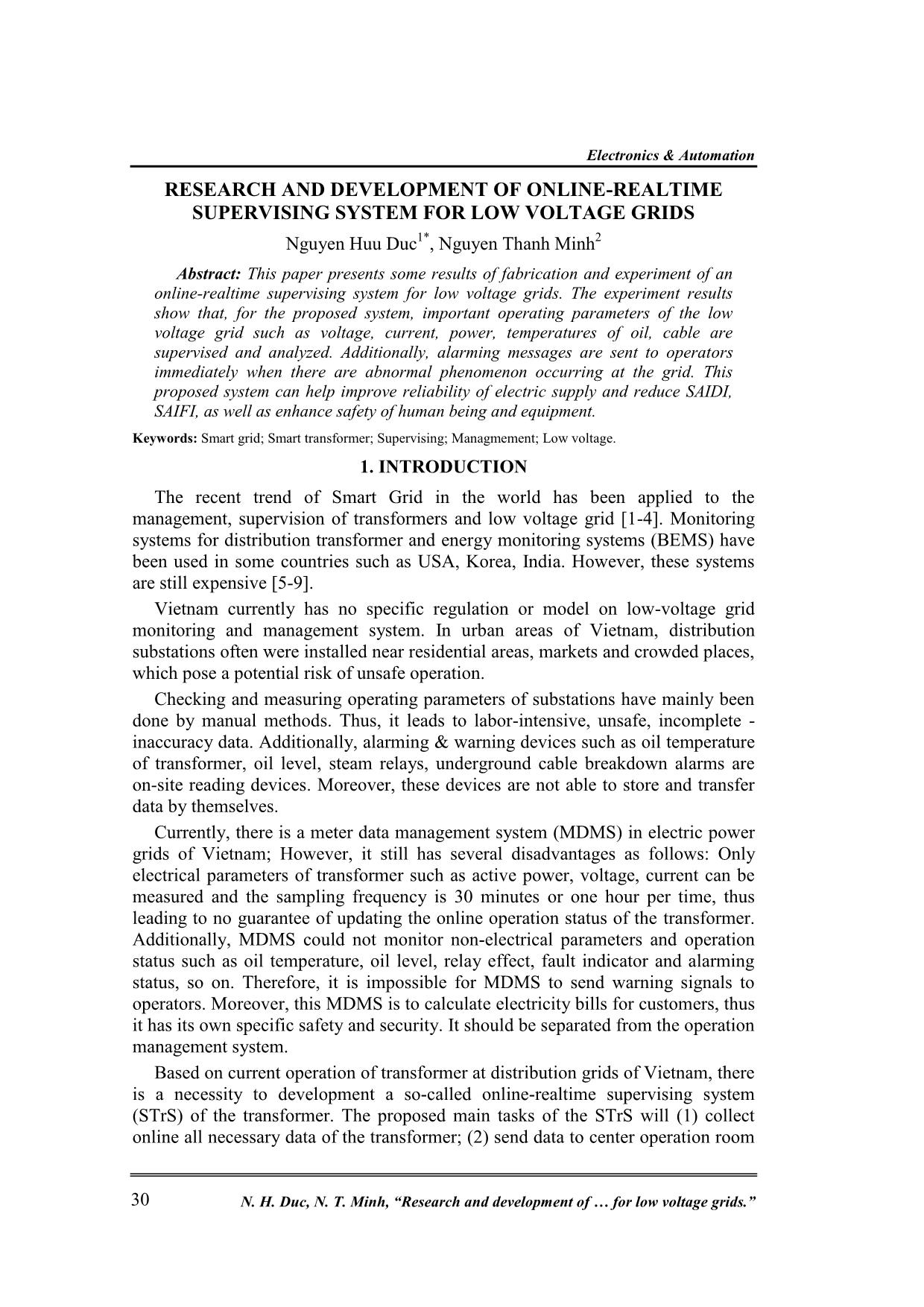
Trang 1
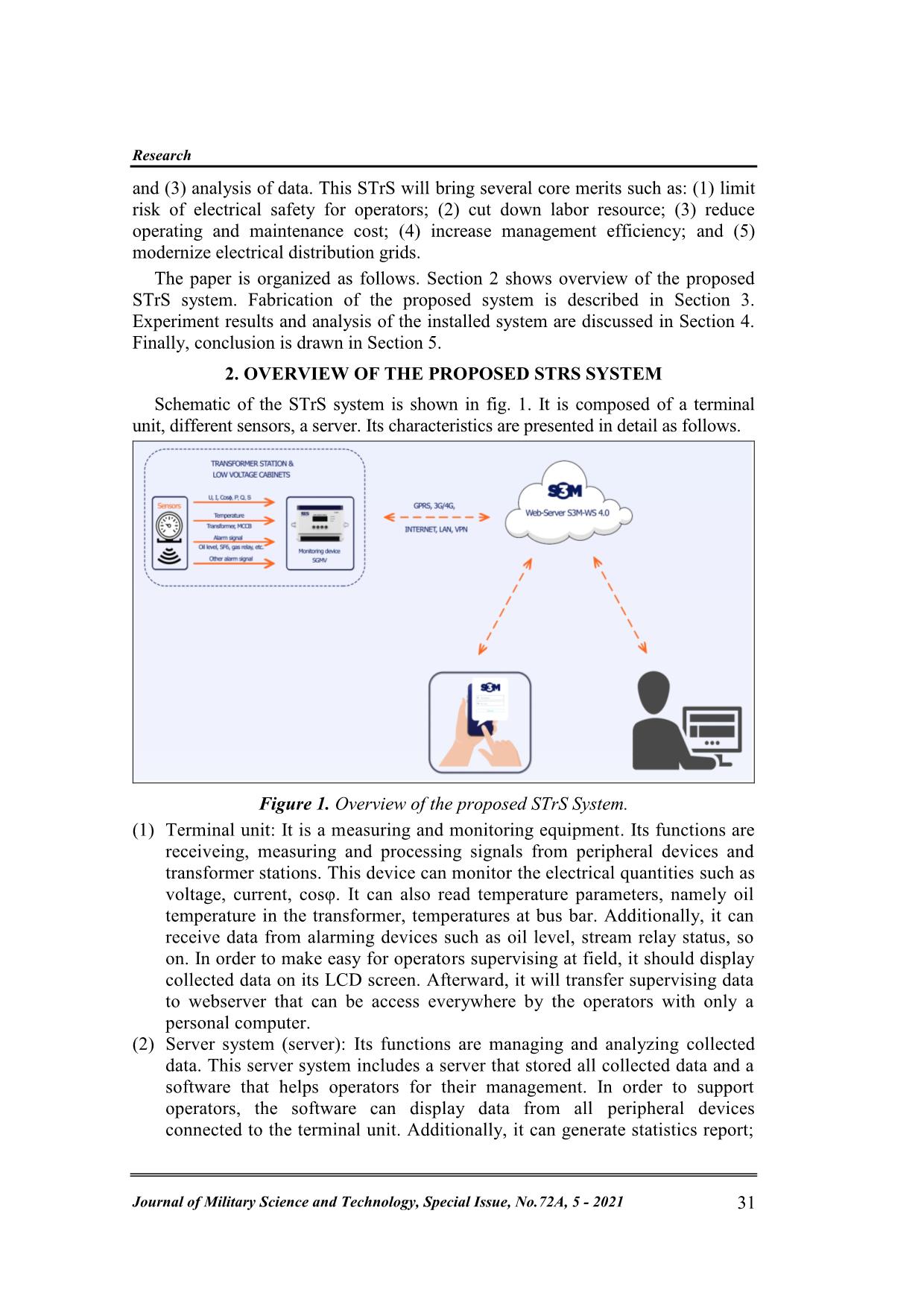
Trang 2
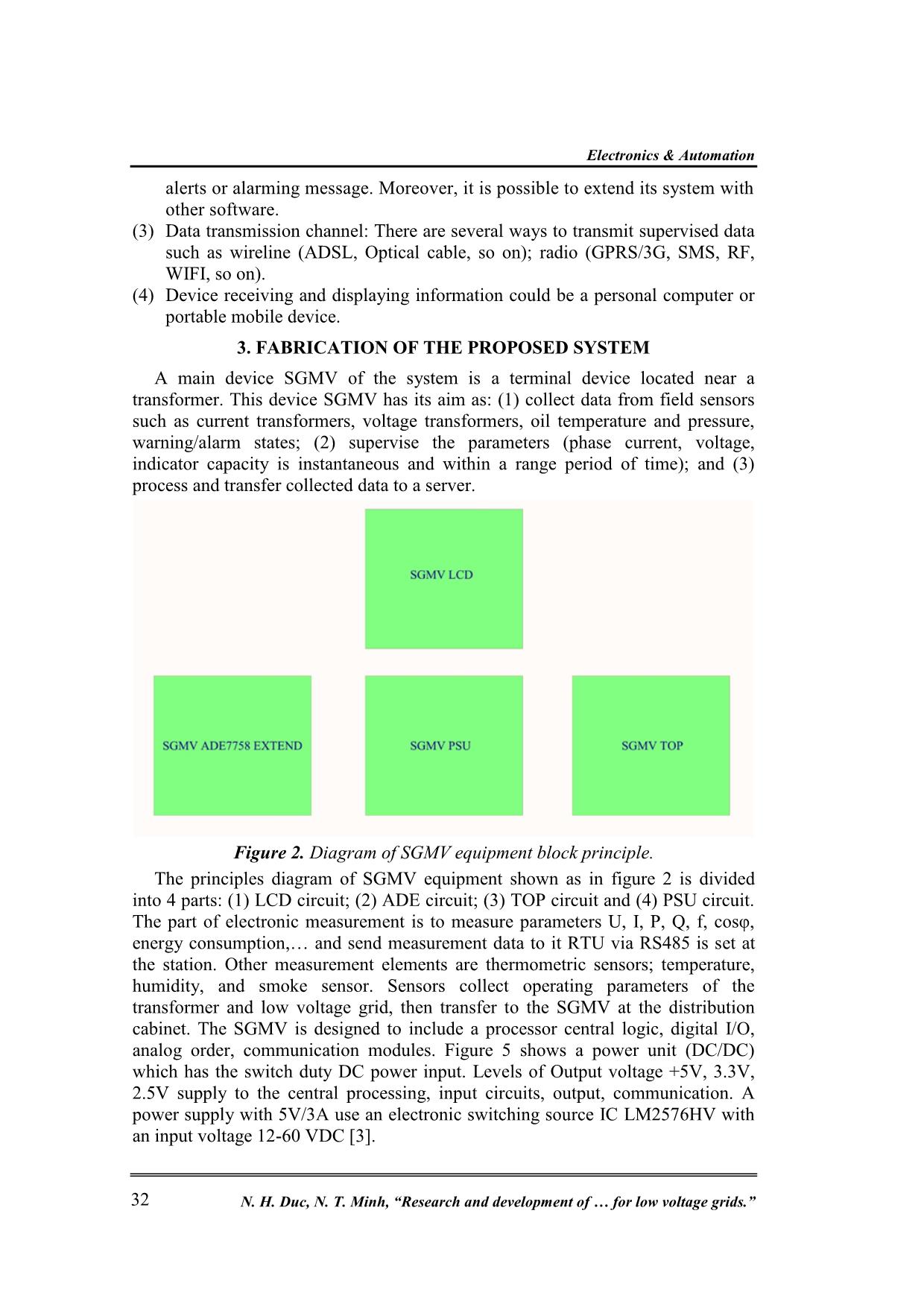
Trang 3
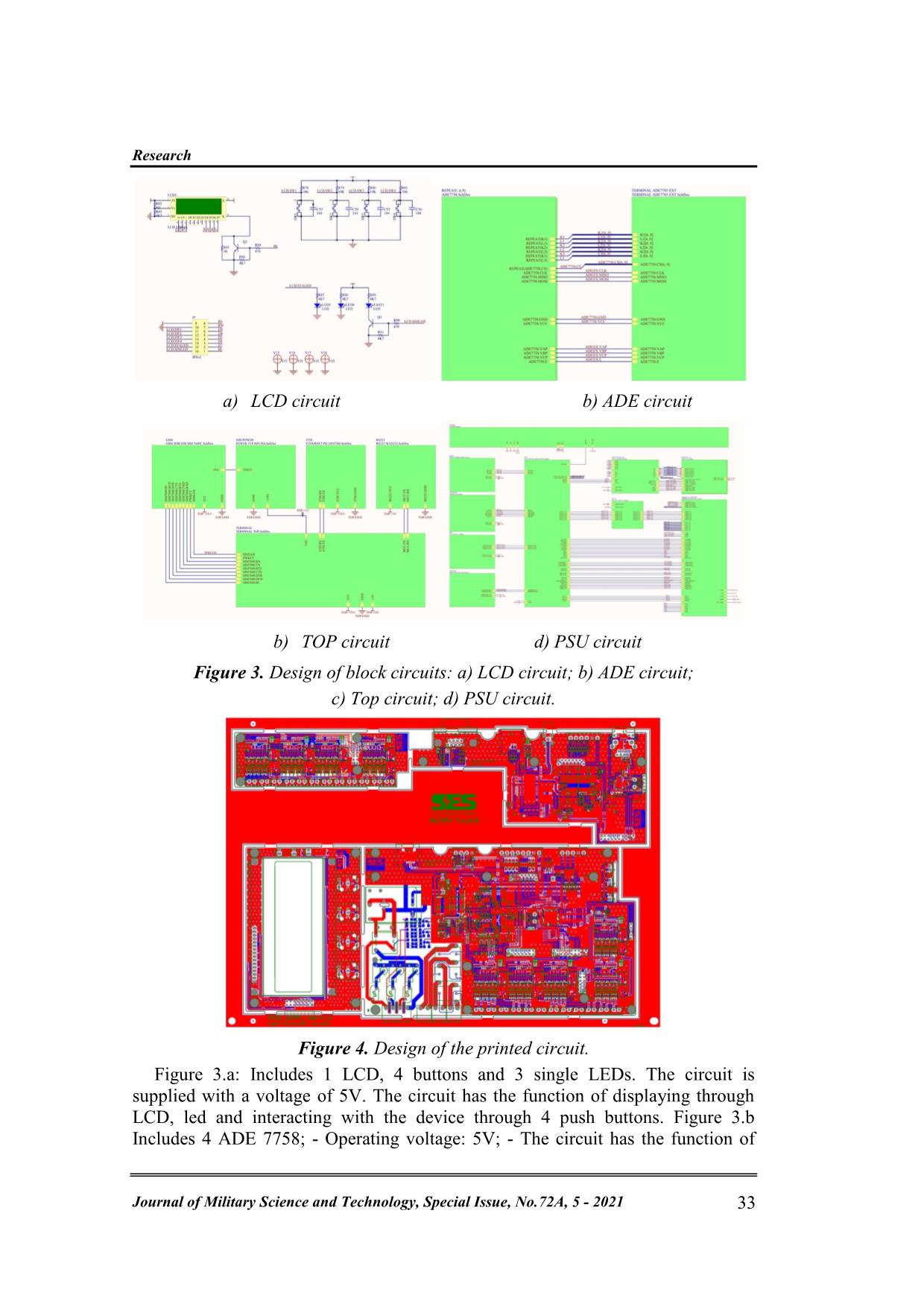
Trang 4
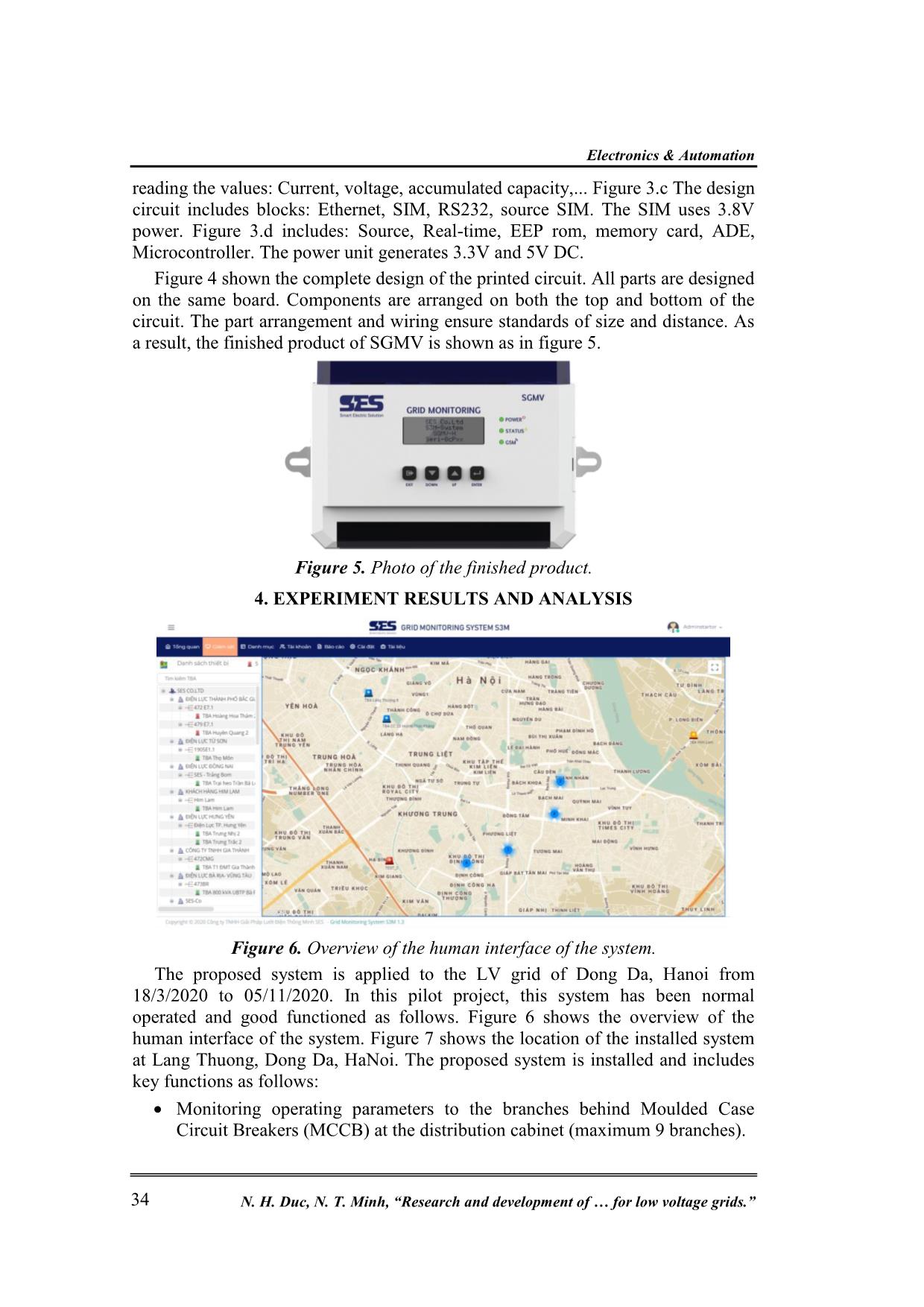
Trang 5
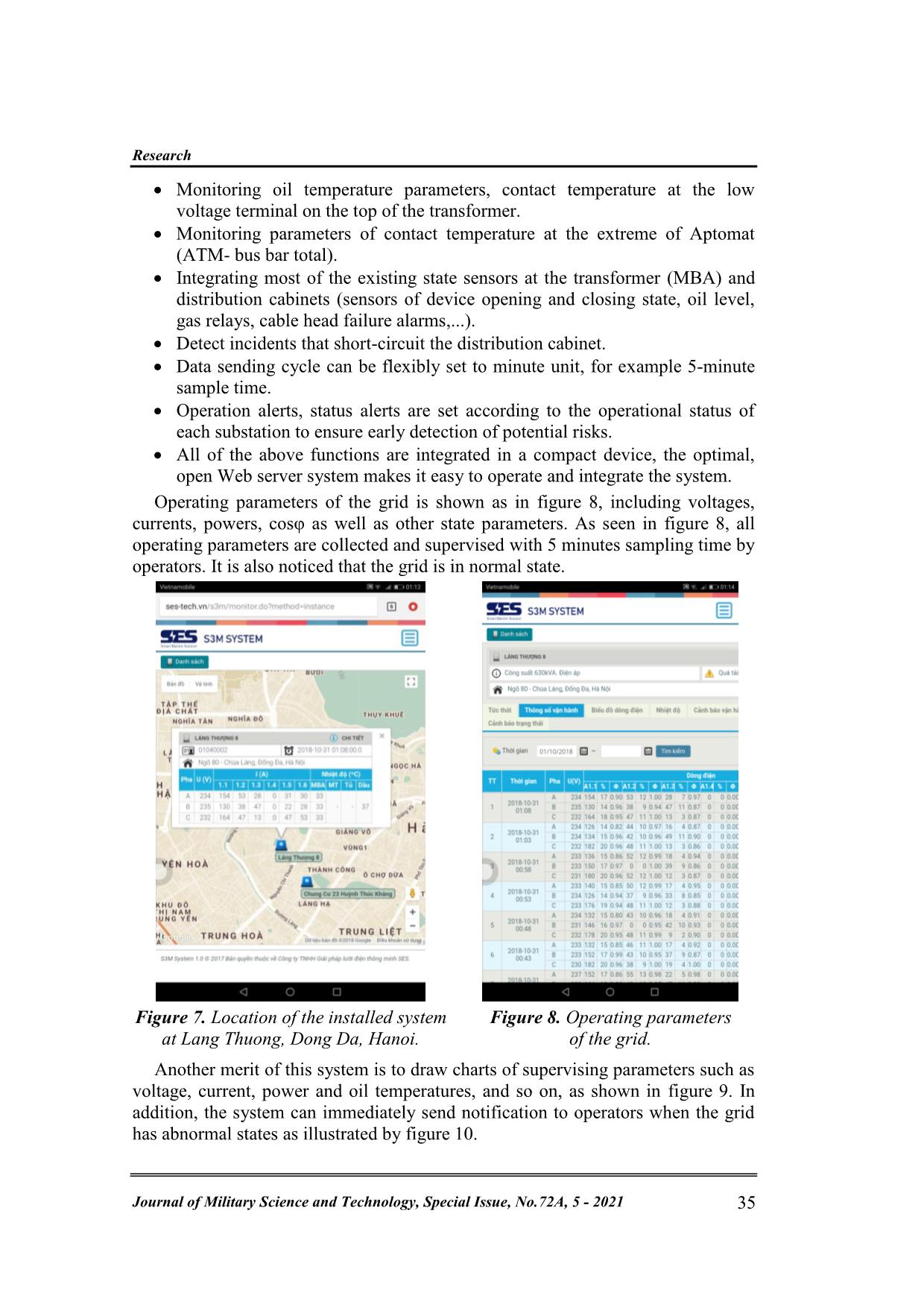
Trang 6
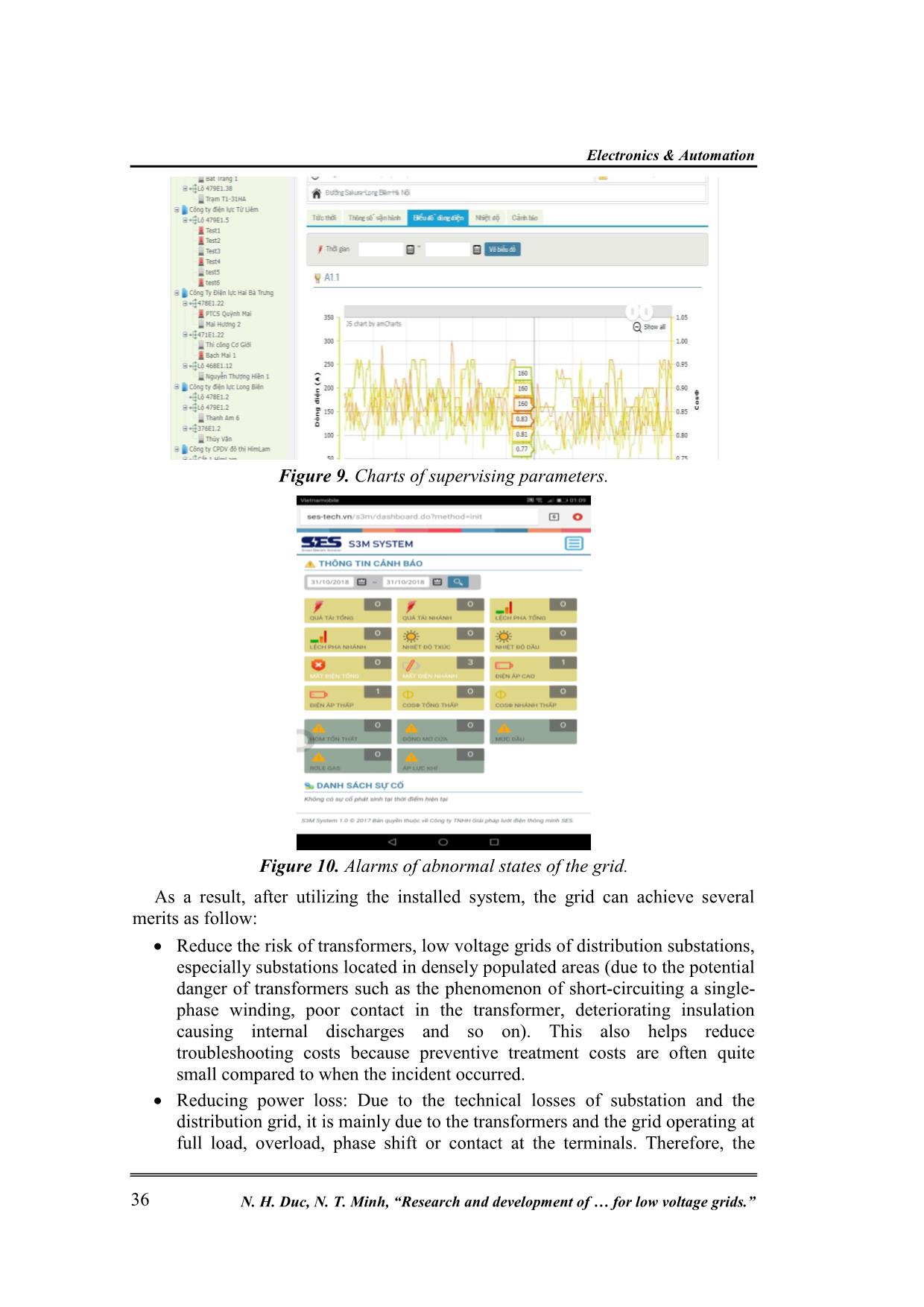
Trang 7
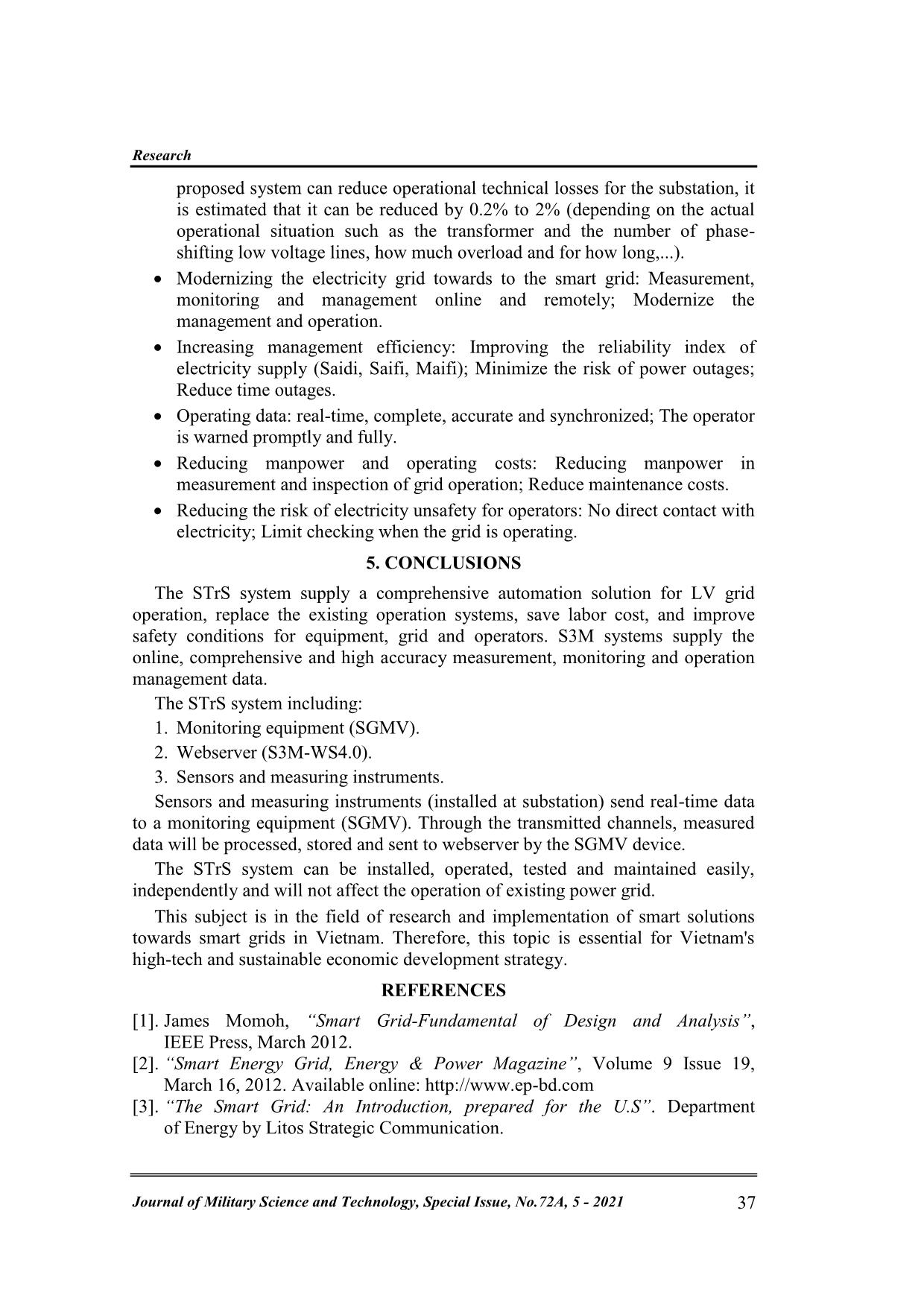
Trang 8
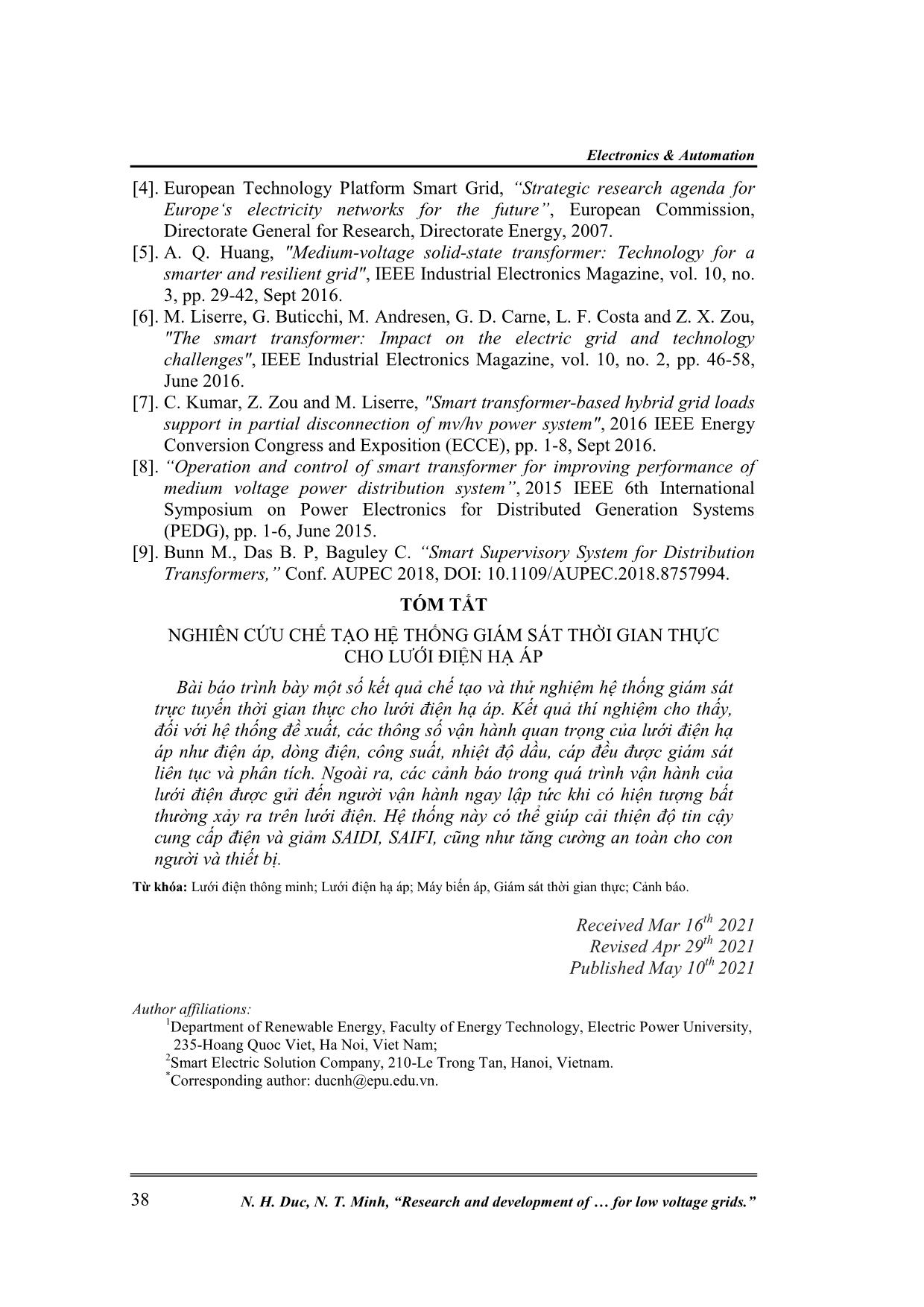
Trang 9
Tóm tắt nội dung tài liệu: Research and development of online - Realtime supervising system for low voltage grids
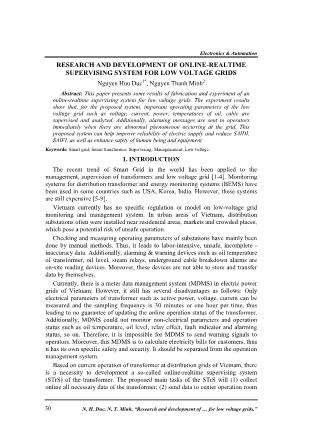
Electronics & Automation N. H. Duc, N. T. Minh, “Research and development of for low voltage grids.” 30 RESEARCH AND DEVELOPMENT OF ONLINE-REALTIME SUPERVISING SYSTEM FOR LOW VOLTAGE GRIDS Nguyen Huu Duc 1* , Nguyen Thanh Minh 2 Abstract: This paper presents some results of fabrication and experiment of an online-realtime supervising system for low voltage grids. The experiment results show that, for the proposed system, important operating parameters of the low voltage grid such as voltage, current, power, temperatures of oil, cable are supervised and analyzed. Additionally, alarming messages are sent to operators immediately when there are abnormal phenomenon occurring at the grid. This proposed system can help improve reliability of electric supply and reduce SAIDI, SAIFI, as well as enhance safety of human being and equipment. Keywords: Smart grid; Smart transformer; Supervising; Managmement; Low voltage. 1. INTRODUCTION The recent trend of Smart Grid in the world has been applied to the management, supervision of transformers and low voltage grid [1-4]. Monitoring systems for distribution transformer and energy monitoring systems (BEMS) have been used in some countries such as USA, Korea, India. However, these systems are still expensive [5-9]. Vietnam currently has no specific regulation or model on low-voltage grid monitoring and management system. In urban areas of Vietnam, distribution substations often were installed near residential areas, markets and crowded places, which pose a potential risk of unsafe operation. Checking and measuring operating parameters of substations have mainly been done by manual methods. Thus, it leads to labor-intensive, unsafe, incomplete - inaccuracy data. Additionally, alarming & warning devices such as oil temperature of transformer, oil level, steam relays, underground cable breakdown alarms are on-site reading devices. Moreover, these devices are not able to store and transfer data by themselves. Currently, there is a meter data management system (MDMS) in electric power grids of Vietnam; However, it still has several disadvantages as follows: Only electrical parameters of transformer such as active power, voltage, current can be measured and the sampling frequency is 30 minutes or one hour per time, thus leading to no guarantee of updating the online operation status of the transformer. Additionally, MDMS could not monitor non-electrical parameters and operation status such as oil temperature, oil level, relay effect, fault indicator and alarming status, so on. Therefore, it is impossible for MDMS to send warning signals to operators. Moreover, this MDMS is to calculate electricity bills for customers, thus it has its own specific safety and security. It should be separated from the operation management system. Based on current operation of transformer at distribution grids of Vietnam, there is a necessity to development a so-called online-realtime supervising system (STrS) of the transformer. The proposed main tasks of the STrS will (1) collect online all necessary data of the transformer; (2) send data to center operation room Research Journal of Military Science and Technology, Special Issue, No.72A, 5 - 2021 31 and (3) analysis of data. This STrS will bring several core merits such as: (1) limit risk of electrical safety for operators; (2) cut down labor resource; (3) reduce operating and maintenance cost; (4) increase management efficiency; and (5) modernize electrical distribution grids. The paper is organized as follows. Section 2 shows overview of the proposed STrS system. Fabrication of the proposed system is described in Section 3. Experiment results and analysis of the installed system are discussed in Section 4. Finally, conclusion is drawn in Section 5. 2. OVERVIEW OF THE PROPOSED STRS SYSTEM Schematic of the STrS system is shown in fig. 1. It is composed of a terminal unit, different sensors, a server. Its characteristics are presented in detail as follows. Figure 1. Overview of the proposed STrS System. (1) Terminal unit: It is a measuring and monitoring equipment. Its functions are receiveing, measuring and processing signals from peripheral devices and transformer stations. This device can monitor the electrical quantities such as voltage, current, cosφ. It can also read temperature parameters, namely oil temperature in the transformer, temperatures at bus bar. Additionally, it can receive data from alarming devices such as oil level, stream relay status, so on. In order to make easy for operators supervising at field, it should display collected data on its LCD screen. Afterward, it will transfer supervising data to webserver that can be access everywhere by the operators with only a personal computer. (2) Server system (server): Its functions are managing and analyzing collected data. This server system includes a server that stored all collected data and a software that helps operators for their management. In order to support operators, the software can display data from all peripheral devices connected to the terminal unit. Additionally, it can generate statistics report; Electronics & Automation N. H. Duc, N. T. Minh, “Research and development of for low voltage grids.” 32 alerts or alarming message. Moreover, it is possible to extend its system with other software. (3) Data transmission channel: There are several ways to transmit supervised data such as wireline (ADSL, Optical cable, so on); radio (GPRS/3G, SMS, RF, WIFI, so on). (4) Device receiving and displaying information could be a personal computer or portable mobile device. 3. FABRICATION OF THE PROPOSED SYSTEM A main device SGMV of the system is a terminal device located near a transformer. This device SGMV has its aim as: (1) collect data from field sensors such as current transformers, voltage transformers, oil temperature and pressure, warning/alarm states; (2) supervise the parameters (phase current, voltage, indicator capacity is instantaneous and within a range period of time); and (3) process and transfer collected data to a server. Figure 2. Diagram of SGMV equipment block principle. The principles diagram of SGMV equipment shown as in figure 2 is divided into 4 parts: (1) LCD circuit; (2) ADE circuit; (3) TOP circuit and (4) PSU circuit. The part of electronic measurement is to measure parameters U, I, P, Q, f, cosφ, energy consumption, and send measurement data to it RTU via RS485 is set at the station. Other measurement elements are thermometric sensors; temperature, humidity, and smoke sensor. Sensors collect operating parameters of the transformer and low voltage grid, then transfer to the SGMV at the distribution cabinet. The SGMV is designed to include a processor central logic, digital I/O, analog order, communication modules. Figure 5 shows a power unit (DC/DC) which has the switch duty DC power input. Levels of Output voltage +5V, 3.3V, 2.5V supply to the central processing, input circuits, output, communication. A power supply with 5V/3A use an electronic switching source IC LM2576HV with an input voltage 12-60 VDC [3]. Research Journal of Military Science and Technology, Special Issue, No.72A, 5 - 2021 33 a) LCD circuit b) ADE circuit b) TOP circuit d) PSU circuit Figure 3. Design of block circuits: a) LCD circuit; b) ADE circuit; c) Top circuit; d) PSU circuit. Figure 4. Design of the printed circuit. Figure 3.a: Includes 1 LCD, 4 buttons and 3 single LEDs. The circuit is supplied with a voltage of 5V. The circuit has the function of displaying through LCD, led and interacting with the device through 4 push buttons. Figure 3.b Includes 4 ADE 7758; - Operating voltage: 5V; - The circuit has the function of Electronics & Automation N. H. Duc, N. T. Minh, “Research and development of for low voltage grids.” 34 reading the values: Current, voltage, accumulated capacity,... Figure 3.c The design circuit includes blocks: Ethernet, SIM, RS232, source SIM. The SIM uses 3.8V power. Figure 3.d includes: Source, Real-time, EEP rom, memory card, ADE, Microcontroller. The power unit generates 3.3V and 5V DC. Figure 4 shown the complete design of the printed circuit. All parts are designed on the same board. Components are arranged on both the top and bottom of the circuit. The part arrangement and wiring ensure standards of size and distance. As a result, the finished product of SGMV is shown as in figure 5. Figure 5. Photo of the finished product. 4. EXPERIMENT RESULTS AND ANALYSIS Figure 6. Overview of the human interface of the system. The proposed system is applied to the LV grid of Dong Da, Hanoi from 18/3/2020 to 05/11/2020. In this pilot project, this system has been normal operated and good functioned as follows. Figure 6 shows the overview of the human interface of the system. Figure 7 shows the location of the installed system at Lang Thuong, Dong Da, HaNoi. The proposed system is installed and includes key functions as follows: Monitoring operating parameters to the branches behind Moulded Case Circuit Breakers (MCCB) at the distribution cabinet (maximum 9 branches). Research Journal of Military Science and Technology, Special Issue, No.72A, 5 - 2021 35 Monitoring oil temperature parameters, contact temperature at the low voltage terminal on the top of the transformer. Monitoring parameters of contact temperature at the extreme of Aptomat (ATM- bus bar total). Integrating most of the existing state sensors at the transformer (MBA) and distribution cabinets (sensors of device opening and closing state, oil level, gas relays, cable head failure alarms,...). Detect incidents that short-circuit the distribution cabinet. Data sending cycle can be flexibly set to minute unit, for example 5-minute sample time. Operation alerts, status alerts are set according to the operational status of each substation to ensure early detection of potential risks. All of the above functions are integrated in a compact device, the optimal, open Web server system makes it easy to operate and integrate the system. Operating parameters of the grid is shown as in figure 8, including voltages, currents, powers, cosφ as well as other state parameters. As seen in figure 8, all operating parameters are collected and supervised with 5 minutes sampling time by operators. It is also noticed that the grid is in normal state. Figure 7. Location of the installed system at Lang Thuong, Dong Da, Hanoi. Figure 8. Operating parameters of the grid. Another merit of this system is to draw charts of supervising parameters such as voltage, current, power and oil temperatures, and so on, as shown in figure 9. In addition, the system can immediately send notification to operators when the grid has abnormal states as illustrated by figure 10. Electronics & Automation N. H. Duc, N. T. Minh, “Research and development of for low voltage grids.” 36 Figure 9. Charts of supervising parameters. Figure 10. Alarms of abnormal states of the grid. As a result, after utilizing the installed system, the grid can achieve several merits as follow: Reduce the risk of transformers, low voltage grids of distribution substations, especially substations located in densely populated areas (due to the potential danger of transformers such as the phenomenon of short-circuiting a single- phase winding, poor contact in the transformer, deteriorating insulation causing internal discharges and so on). This also helps reduce troubleshooting costs because preventive treatment costs are often quite small compared to when the incident occurred. Reducing power loss: Due to the technical losses of substation and the distribution grid, it is mainly due to the transformers and the grid operating at full load, overload, phase shift or contact at the terminals. Therefore, the Research Journal of Military Science and Technology, Special Issue, No.72A, 5 - 2021 37 proposed system can reduce operational technical losses for the substation, it is estimated that it can be reduced by 0.2% to 2% (depending on the actual operational situation such as the transformer and the number of phase- shifting low voltage lines, how much overload and for how long,...). Modernizing the electricity grid towards to the smart grid: Measurement, monitoring and management online and remotely; Modernize the management and operation. Increasing management efficiency: Improving the reliability index of electricity supply (Saidi, Saifi, Maifi); Minimize the risk of power outages; Reduce time outages. Operating data: real-time, complete, accurate and synchronized; The operator is warned promptly and fully. Reducing manpower and operating costs: Reducing manpower in measurement and inspection of grid operation; Reduce maintenance costs. Reducing the risk of electricity unsafety for operators: No direct contact with electricity; Limit checking when the grid is operating. 5. CONCLUSIONS The STrS system supply a comprehensive automation solution for LV grid operation, replace the existing operation systems, save labor cost, and improve safety conditions for equipment, grid and operators. S3M systems supply the online, comprehensive and high accuracy measurement, monitoring and operation management data. The STrS system including: 1. Monitoring equipment (SGMV). 2. Webserver (S3M-WS4.0). 3. Sensors and measuring instruments. Sensors and measuring instruments (installed at substation) send real-time data to a monitoring equipment (SGMV). Through the transmitted channels, measured data will be processed, stored and sent to webserver by the SGMV device. The STrS system can be installed, operated, tested and maintained easily, independently and will not affect the operation of existing power grid. This subject is in the field of research and implementation of smart solutions towards smart grids in Vietnam. Therefore, this topic is essential for Vietnam's high-tech and sustainable economic development strategy. REFERENCES [1]. James Momoh, “Smart Grid-Fundamental of Design and Analysis”, IEEE Press, March 2012. [2]. “Smart Energy Grid, Energy & Power Magazine”, Volume 9 Issue 19, March 16, 2012. Available online: [3]. “The Smart Grid: An Introduction, prepared for the U.S”. Department of Energy by Litos Strategic Communication. Electronics & Automation N. H. Duc, N. T. Minh, “Research and development of for low voltage grids.” 38 [4]. European Technology Platform Smart Grid, “Strategic research agenda for Europe‘s electricity networks for the future”, European Commission, Directorate General for Research, Directorate Energy, 2007. [5]. A. Q. Huang, "Medium-voltage solid-state transformer: Technology for a smarter and resilient grid", IEEE Industrial Electronics Magazine, vol. 10, no. 3, pp. 29-42, Sept 2016. [6]. M. Liserre, G. Buticchi, M. Andresen, G. D. Carne, L. F. Costa and Z. X. Zou, "The smart transformer: Impact on the electric grid and technology challenges", IEEE Industrial Electronics Magazine, vol. 10, no. 2, pp. 46-58, June 2016. [7]. C. Kumar, Z. Zou and M. Liserre, "Smart transformer-based hybrid grid loads support in partial disconnection of mv/hv power system", 2016 IEEE Energy Conversion Congress and Exposition (ECCE), pp. 1-8, Sept 2016. [8]. “Operation and control of smart transformer for improving performance of medium voltage power distribution system”, 2015 IEEE 6th International Symposium on Power Electronics for Distributed Generation Systems (PEDG), pp. 1-6, June 2015. [9]. Bunn M., Das B. P, Baguley C. “Smart Supervisory System for Distribution Transformers,” Conf. AUPEC 2018, DOI: 10.1109/AUPEC.2018.8757994. TÓM TẮT NGHIÊN CỨU CHẾ TẠO HỆ THỐNG GIÁM SÁT THỜI GIAN THỰC CHO LƯỚI ĐIỆN HẠ ÁP Bài báo trình bày một số kết quả chế tạo và thử nghiệm hệ thống giám sát trực tuyến thời gian thực cho lưới điện hạ áp. Kết quả thí nghiệm cho thấy, đối với hệ thống đề xuất, các thông số vận hành quan trọng của lưới điện hạ áp như điện áp, dòng điện, công suất, nhiệt độ dầu, cáp đều được giám sát liên tục và phân tích. Ngoài ra, các cảnh báo trong quá trình vận hành của lưới điện được gửi đến người vận hành ngay lập tức khi có hiện tượng bất thường xảy ra trên lưới điện. Hệ thống này có thể giúp cải thiện độ tin cậy cung cấp điện và giảm SAIDI, SAIFI, cũng như tăng cường an toàn cho con người và thiết bị. Từ khóa: Lưới điện thông minh; Lưới điện hạ áp; Máy biến áp, Giám sát thời gian thực; Cảnh báo. Received Mar 16 th 2021 Revised Apr 29 th 2021 Published May 10 th 2021 Author affiliations: 1 Department of Renewable Energy, Faculty of Energy Technology, Electric Power University, 235-Hoang Quoc Viet, Ha Noi, Viet Nam; 2 Smart Electric Solution Company, 210-Le Trong Tan, Hanoi, Vietnam. * Corresponding author: ducnh@epu.edu.vn.
File đính kèm:
 research_and_development_of_online_realtime_supervising_syst.pdf
research_and_development_of_online_realtime_supervising_syst.pdf

